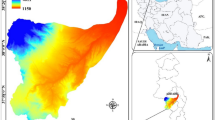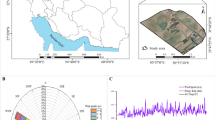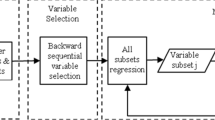Abstract
In this study, it is aimed to apply to estimate the plant height of grass pea (Lathyrus sativus L.) plant, data mining methods MARS (Multivariate Adaptive Regression Splines) and Bagging MARS (Bootstrap Aggregating Multivariate Adaptive Regression Splines) algorithms. Plant height, dry leaf, dry stalk, wet leaf and wet stalk were considered in different lines as plant characteristics. Plants consist of Leo, Ela, 504, Line-17, 481, 563, 528, Coloratus, Karadag, İptas, Elazig Pop. and Gurbuz lines. In the experiment carried out in 12 lines and 3 replication plots, 36 plants were examined. Belonging to the MARS algorithm that predicts plant height, r (correlation coefficient), R2 (determination coefficient), Adjust R2, Standard deviation ratio (SDratio), Root-mean-square error (RMSE), Relative root mean square error (RRMSE), Performance index (PI), Mean error (ME), Relative approximation error (RAE), Mean absolute percentage error (MAPE) and Mean absolute deviation (MAD) values, were found 0.867, 0.752, 0.701, 0.498, 2.459, 5.937, 3.180, 0, 0.058, 4.733 and 1.941, respectively. The same statistics of the Bagging MARS algorithm were obtained as 0.901, 0.811, 0.811, 0.435, 2.148, 5.212, 2.878, − 0.056, 0.050, 4.101 and 1.735, respectively. To compute the prediction value, the samples were split in two sets, a training one and a test one (70% and 30% of the total samples). An iterative process (1000 iterations) was run with each successive loop designing the matrices randomly. In MARS and Bagging MARS algorithms, no overfitting problem was observed under a set of independent variables consisting of plant height and plant morphological characteristics. It was concluded that both algorithms are a good statistical tool in revealing the farmers’ trends in crop production at the observed location and produce important clues in increasing plant height. However, in the light of the findings of this study, the results of the Bagging MARS algorithm can be evaluated primarily.


Similar content being viewed by others
Data availability
The datasets used and analyzed during the current study are available from the corresponding author on reasonable request.
References
Akin M, Eyduran SP, Eyduran E, Reed BM (2020) Analysis of macro nutrient related growth responses using multivariate adaptive regression splines. Pl. Cell. Tissue Organ Culture (PCTOC) 140:661–670. https://doi.org/10.1007/s11240-019-01763-8
Akyol M (2011) Yaşam Çözümlemesine Yeni Bir Yaklaşım: MARS. Ankara Üniversitesi Sağlık Bilimleri Enstitüsü, Doktora Tezi, Ankara
Anonim (2019) T.C. Başbakanlık Devlet Meteoroloji İşleri Genel Müdürlüğü, Rize İl Müdürlüğü Kayıtları.
Balabanlı C, Kara B (2003) Determination of some agronomic characteristics and yield potential common chickling (Lathyrus Sativus L.) Lines under Isparta conditions. J Field Crops Central Res Inst 12(1):57–63
Barpete S (2015) Genetic associations, variability and diversity in biochemical and morphological seed characters in Indian grass pea (Lathyrus sativus L.) accessions. Fresenius Environ Bull 24:1–6
Basaran U, Acar Z, Önal-Ascı Ö, Mut H, Ayan İ (2007) Mürdümük (Lathyrus sp.) Türlerinin Önemi, Tarimda Kullanim Olanaklari Ve Zararli Madde İçerikleri. J of Fac of Agric 22(1):139–148
Breiman L (1996) Bagging predictors. Mach Learn 24:123–140
Catal Mİ, Bakoglu A (2018) In vitro regeneration techniques in the grass pea (Lathyrus sativus L.) plant. Eur J Forest Sci 6(2):56–62
Eyduran E (2020) ehaGoF: Calculates Goodness of Fit Statistics. R package version 0.1.0. URL: https://CRAN.Rproject.org/package=ehaGoF. (Access date: Sep 30, 2022).
Eyduran E, Akin M, Eyduran SP (2019) Application of Multivariate Adaptive Regression Splines in Agricultural Sciences through R Software. Nobel Akademik Yayıncılık, p112, ISBN:978–605–2149–81–2.
Frank IE (1995) Tutorial: modern nonlinear regression methods. Chemom Intell Lab Syst 27:1–19
Friedman JH (1991) Multivariate adaptive regression spline. Annals Statist 19:1–141
Gandomi AH, Roke DA (2013) Intelligent formulation of structural engineering systems. In: Seventh MIT Conference on Computational Fluid and Solid Mechanics-Focus: Multiphysics and Multiscale, 12–14 June, Cambridge, USA
Genç H, Şahin A (2001) Batı Akdeniz ve Güney Ege Bölgesinde yetişen Bazı Lathyrus L. türleri üzerinde sitotaksonomik araştırmalar. III S.d.u. Fen Bilimleri Dergisi 5(1):98–112
Gocheva-Ilieva SG, Iliev IP (2010) Parametric and nonparametric empirical regression models: case study of copper bromide laser generation. Hindawi Publishing Corparat Mathemat Prob Eng. https://doi.org/10.1155/2010/697687
Grela ER, Rybin´ski W, Matras J, Sobolewska S, (2012) Variability of phenotypic and morphological characteristics of some Lathyrus sativus L. and Lathyrus cicera L. accessions and nutritional traits of their seeds. Genetic Res Crop Evolut 59:1687–1703
Grzesiak W, Zaborski D (2012) Examples of the use of data mining methods in animal breeding. (Book) ISBN 978–953–51–0720–0.
Gül İ, Sümerli M, Yılmaz Y (2004) Determination of yield and yield components of some Grasspea (Lathyrus sativus L.) lines under diyarbakir conditions. Tarım Bilimleri Dergisi 10(4):416–421
Hastie T, Tibshirani R, Friedman J (2001) The elements of statistical learning: data mining. Inference and Prediction Springer-Verlag, New York
Hasyim M, Rahayu DS, Muliwati NE, Hayuhantika D, Puspasari R, Anggreini D, Hastari RC, Hartanto S, Utomo H (2018) Bootstrap aggregating multivariate adaptive regression splines bagging MARS to analyse the lecturer research performance in private university wma-mathcomtech 2018. IOP Conf Series J Phys Conf Ser 1114:012117. https://doi.org/10.1088/1742-6596/1114/1/012117
Kenicer GJ, Kajita T, Pennington RT, Murata J (2005) Systematics and biogeography of Lathyrus (Leguminosae) based on internal transcribed spacer and cpDNA sequence data. Am J Botany 92:1199–1209
Kökten K, Bakoğlu A (2011) Elazığ Koşullarında Mürdümük (Lathyrus sativus L.)’te Farklı Sıra Arasının Tohum Verimi ve Verim Öğeleri Üzerine Etkisi. Bingöl Üniversitesi Fen Bilimleri Dergisi 1(1):37–42
Kosev VI, Vasileva VM (2019) Morphological characterization of Grass pea (Lathyrus sativus L.) varieties. J Agricult Sci Sri Lanka 14(2):67–76
Księżak J, Bojarszczuk J (2020) The effect of sowing method on the yield of grass pea (Lathyrus Sativus) cultivated in an organic system. Appl Ecol Environ Res 18(4):5355–5366
Kulekçi M, Eyduran E, Altın AY, Tariq MM (2022) Usefulness of MARS and bagging MARS algorithms in prediction of honey production in beekeeping enterprises from Elazig Province of Turkey. Pakistan Journal of Zoology (PJZ) 54(3):1087–1093. https://doi.org/10.17582/journal.pjz/20200309160354
Kumar S, Bejiga G, Ahmed S, Nakkoul H, Sarker A (2011) Genetic improvement of grass pea for low neurotoxin (ODAP) content. Food Chem Toxicol 49:589–600
Kumar S, Gupta P, Barpete S, Sarker A, Amri A, Mathur PN, Baum M (2013) Grass pea. In: Singh M, Upadhyaya HD and Bisht IS (eds) Genetic and Genomic Resources for Grass pea Improvement. pp. 269–293.
Kunn M Johnson K (2013). Applied predictive modeling. NY. Doi: https://doi.org/10.1007/978-1-4614-6849-3.
Liddle AR (2007) Information criteria for astrophysical model selection. Monthly Not Royal Astron Soc Letters 377:L74–L78
Makoi JHJR, Ndakidemi PA (2011) Changes in plant growth, nutrient dynamics and accumulation of flavonoids and anthocyanins by manipulating the cropping systems involving legumes and cereals- a review. Aust J Agric Eng 2(3):56–65
Mendeş, M (2013) Uygulamalı Bilimler İçin İstatistik ve Araştırma Yöntemleri. Kriter Yayınevi, İstanbul, ISBN:978–605–5863–99–9.
Öten M, Kiremitçi S, Erdurmuş C (2017a) Determination of characters associated with seed yield and hay yield by path and correlation analysis in grass pea (Lathyrus sativus L.). Derim 34(1):72–78
Öten M, Kiremitçi S, Erdurmuş C (2017b) The determination of yield characteristics of some grass pea (Lathyrus sativus L.) lines collected from antalya natural flora. Ege Üniv Ziraat Fak Derg 54(1):17–26
Özyiğit Y, Bilgen M (2003) The Effect of Different Cutting Stages on The Yield, Quality and Agricultural Characteristics of Some Forage Legume - Bee Plants. Türkiye 5. Tarla Bitkileri Kongresi 13–17 Ekim 2003, Diyarbakir
R Core Team (2020) R: A language and environment for statistical computing. Vienna, Austria: R Foundation for Statistical Computing. URL: https://www.R-project.org/ (access date: September 30, 2022)
RybiñskiBaszczakFornal WWJ (2006) Seed microstructure and genetic variation of characters in selected grass-pea mutants (Lathyrus sativus L.). International Agrophysics 20:317–326
Sutton CD (2005) Classification and Regression Trees, Bagging, and Boosting Handbook of Statistics Vol. 24: 303-329
Takma C, Atil H, Aksakal V (2012) Comparison of multiple linear regression and artificial neural network models goodness of fit to lactation milk yields. Kafkas Üniversitesi Veteriner Fakültesi Dergisi 18:941–944
Tamburino R, Guida V, Pacifico S, Parente Di Maro A (2012) Nutritional values and radical scavenging capacities of grass pea (Lathyrus sativus L.) seeds in valle agricola district. Italy. Aust Jour of Crop Sci 6(1):149–156
VazPatto MC, Skiba B, Pang ECK, Ochatt SJ, Lambein F, Rubiales D (2006) Lathyrus improvement for resistance against biotic and abiotic stresses: from classical breeding to marker assisted selection. Euphytica 147:133–147
Willmott C, Matsuura K (2005) Advantages of the mean absolute error (MAE) over the root mean square error (RMSE) in assessing average model performance. Clim Res 30:79–82
Author information
Authors and Affiliations
Corresponding author
Additional information
Communicated by B. Zheng.
Publisher's Note
Springer Nature remains neutral with regard to jurisdictional claims in published maps and institutional affiliations.
Rights and permissions
Springer Nature or its licensor (e.g. a society or other partner) holds exclusive rights to this article under a publishing agreement with the author(s) or other rightsholder(s); author self-archiving of the accepted manuscript version of this article is solely governed by the terms of such publishing agreement and applicable law.
About this article
Cite this article
Çatal, M.İ., Celik, S. & Bakoglu, A. Practicability of MARS and bagging MARS algorithms in prediction of plant length of grass pea (Lathyrus sativus L.) in Turkey. Acta Physiol Plant 45, 112 (2023). https://doi.org/10.1007/s11738-023-03587-8
Received:
Revised:
Accepted:
Published:
DOI: https://doi.org/10.1007/s11738-023-03587-8




